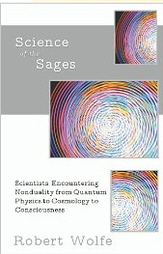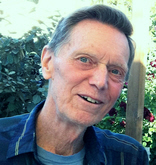Professor Brian Josephson of Cambridge University, winner of a Nobel Prize in physics in 1973, has witnessed quantum effects on a scale big enough to see. "Quantum is incomprehensible even to scientists (1).... We don't have a clear mental picture of what is going on....You could say the theory is not completely logical... .You might say the universe is a lot more subtle than we thought... .Nature is not just lumps of matter, it's some kind of energy pattern.... Certainly things are not made up out of particles.... We do have some sense that 'observation' might help to construct reality, and that comes close to the idea that thought is involved in the nature of reality.... Some features of mysticism can be connected quite well with properties discovered by science; but I think mysticism goes beyond science. I believe aspects of nature, deeper than those discovered by science, are understood in mysticism....The methods of science have so far failed to grasp the subtleties in the way mystical experience has. (2) Physicist Fritjof Capra (The Tao of Physics): *** Physicist/astronomer David Darling, in Zen Physics, treats (among other issues) the "intimate connection between the mind of conscious observers and the bringing into being of what is real." Both (subatomic) energy particles (such as the photons of light) and matter particles (such as electrons—a constituent of all atoms) exhibit both wave and particle properties; in other words diffuse-like and point-like conditions "superimposed" on a fundamental condition: atomic reality is conditional, or relative. And neither energy nor matter can be accelerated to greater than the speed of light,(3) at least in our region of the universe.(4) A particle's "wave function" tells us that it does not reside at some particular point in space during the moments when it is not being "observed," or (in scientific jargon, "measured"). To this extent, it can be said that a particle does not specifically "exist" when it is not observed: "They have no independent, enduring reality."(5) It is not just that we don't know where they are. Eminent physicist John Wheeler has stated that this quantum principle "destroys the concept of the world as just 'sitting out there'....In some strange sense, the universe is a participatory universe." As a consequence of a conscious action, observation, particles of energy and matter are evoked from a condition of potentiality or possibility to states of tangible materiality and its subsequent events. The phenomenon is called by scientists "wave function collapse," the collapse in which the expectation of our observation becomes an actuality. When you set out to measure, with your laboratory equipment, a particle as a wave, it appears as a wave; were your intention to measure a particle as a particle, it would be present in that form. "This is a staggering conclusion... when one remembers that all of the material universe is comprised of subatomic particles!...our most fundamental branch of science implies (the) world cannot even be said to exist outside of the subjective act of observation."(6) Rainer Maria Rilke makes this same point in a poem: I know that nothing has ever been real Our desire, as Darling describes, to determine reality based on a dualistic choice—this/that, either/or— "actually influences reality in a most fundamental way...our [conscious] intervention fragments the continuous wavelike [indeterminate] nature of the world into separate, discrete particles'' of matter or energy, thing or event. "...we break our surroundings down into isolated objects" at the subatomic scale; "a dualistic split from the normal, ongoing state of continuity to a transient state of individualism." Darling goes farther: "...not only is observership [subjective participation] a mandatory requirement for making reality tangible, but every component of the universe— down to the level of each subatomic particle—is in some peculiar sense immediately 'aware' of what is going on around it." An experiment can be set up to begin its determination of a particle as a particle, but change the intent (mid-experiment) to determining its wavelike property—in which case, experiment has shown, the particle will accommodate the intent of the "change-of-mind" of the observer. In other words, a photon "somehow knew what [preference, or choice) lay ahead." The sense of a quanton "being aware of what is going on around it" is reflected in the physics term "nonlocality." Darling: "Nonlocality amounts to zero-delay [instant] communication between two particles, no matter what their separation in distance." Cause an atom to emit two separate photons, at the same time but in opposite directions. If the electric field of one of them is vibrating in an "up" polarization, the other by the nature of known physical properties—will always be polarized in a "down" configuration (or vice versa). But until a measurement is performed (if any), the state of polarization of either quanton is undefined (not simply unclear at this point). Measure (or observe) the polarized state of either of the quantons (wave-function collapse)(7) and the (alternate) state of the other quanton is instantaneously a determined fact, or actuality—"irrespective of the distance between the particles"; this effect is "real and inescapable." Faster than any energetic signal could travel between the pair—that is, faster than the upward communicable limit of the speed of light—the pair has an immediate awareness of each other's manifested condition, enough so to present a determined state of being.(8) It is mind that "thereby makes matter real....The universe [from which our minds originate] creates itself, out of itself, moment by moment." Darling adds: "'Subject' [mind] and 'object' [matter] cannot be treated apart...." Motion and rest, energy and mass, time and space are all relative, science tells us: "the world cannot be accurately viewed as a complex of distinct things.... Nothing stands apart.... Incredibly, modern physics—which is the most advanced product of our dualistic way of thinking— has shown that dualism is no longer tenable." Ironically, it is the "reductionist"—divisive—nature of science which has itself led to such a discovery: through it, "we have found that reality has no boundaries." Notes: Extract from the book: Science of the Sages: Scientists Encountering Nonduality from Quantum Physics to Cosmology to Consciousness. |
|||
|
|||


www.advaita.org.uk
Advaita for the 21st Century



Book Extract
Nothing Stands Apart
Robert Wolfe

Robert has labored as an auto assembly line worker in Detroit, as a carnival worker, a journalist in New York City, on a farm of a Zen community in California, as a landscaper, a financial consultant, a janitor. He now lives in Ojai, California and writes about the reality that surrounds and includes us.
Website: www.livingnonduality.org/
Biography
BOOK DETAILS
Publisher:Karina Library Press
ISBN: 978-1-937902-04-9
Format : Paperback
Pages: 174
List Price: £9.99, US$18.00
Where to Buy
AUTHOR DETAILS

